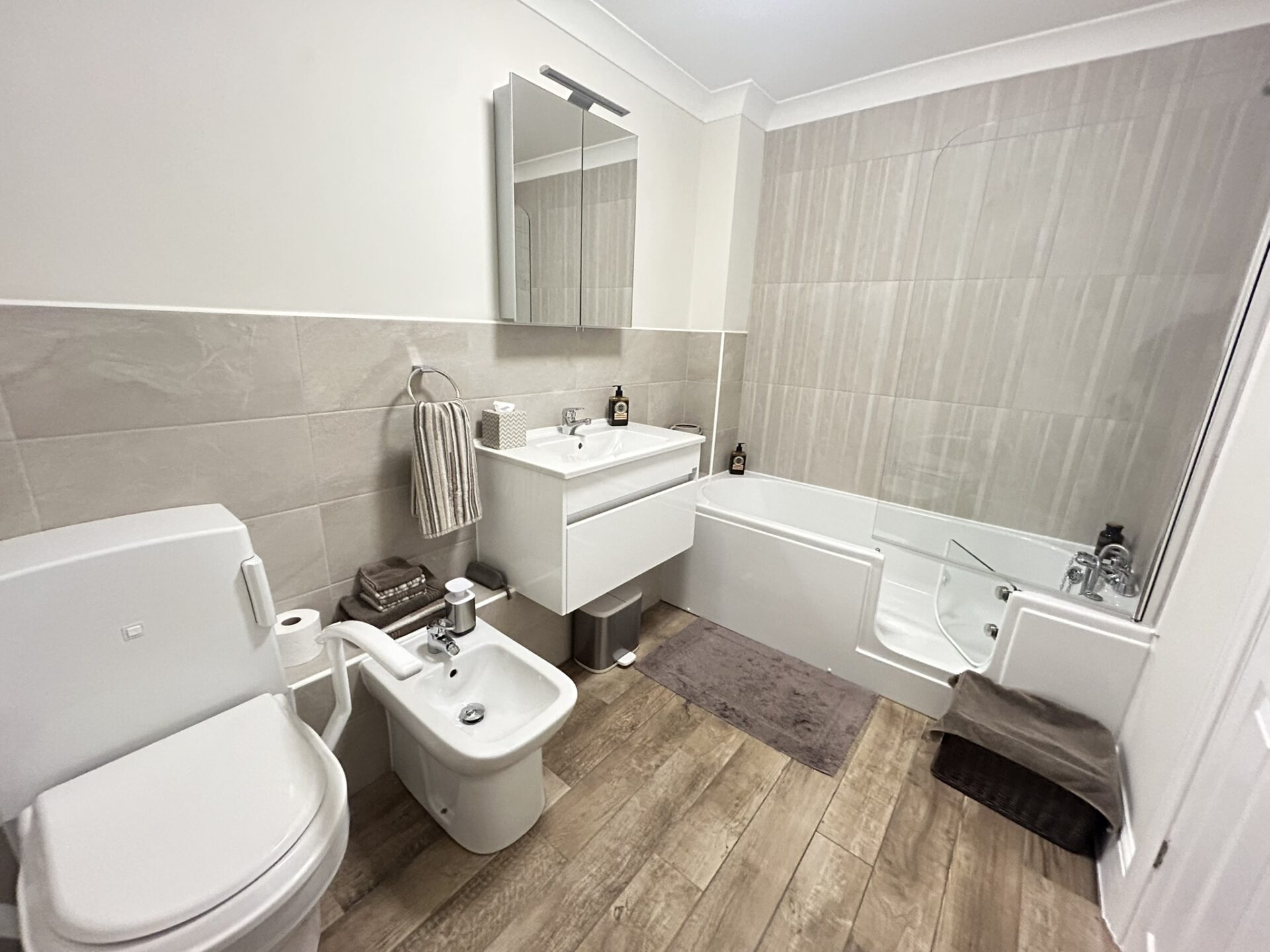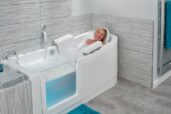The 2019-20 English Housing Survey revealed that that 53% of households (one million) do not have the adaptations they need – up from 45% (864,000) in 2014-15. A third (33%) of households that need adaptations say their home is unsuitable and they would like to move. These are topline figures and there are variations to consider within them, but there is clearly a growing issue across the UK property sector as both our population ages and people adapt to the changing housing market including those that are part of Generation Rent.
Those that are renting need to check their tenancy agreements and consult with their landlords to find out what changes if any can be made within their contract. Where cost is a consideration, which it will be for many, what can be resolved within the budget available, can VAT relieve be offered, and are their any suitable grants available?
For those that have assessed their options and are able to start a new accessible bathroom project we have put together 15 ideas worth considering as part of your bathroom adaptation.
1. Integrate calming blue tones into your bathroom design
Integrating calming blue tones into your bathroom design can create a tranquil and soothing atmosphere. Blue is often associated with feelings of calmness, relaxation, and serenity. By incorporating shades of blue into your bathroom, such as on the walls, tiles, or accessories, you can create a spa-like ambiance that promotes relaxation and rejuvenation. Disabled showers or walk-in baths do not have to be clinical. Speak to our expert design to find out how your prefered colour scheme can be integrated into your project.
2. Unwind a tub-style walk-in bath with extra wide door
There are various types of walk-in bath available such as walk-in shower baths with a defined showering enclosure, standard walk-in baths which look like a traditional bath with a door added, and tub-style walk-in baths which are generally not as long and feature an upright seating position.
This final category is generally most suitable for bathers which need to transition from a wheelchair or walking aid. Certain designs such as the Tranquility tub-style bath feature an extra wide door making it quite straight forward to slide-in from a wheelchair, particulalry if it can be set to the same height as the bath. Whilst a wet room or level access shower is generally more suitable for disabled bathers, there are certain circumstances where a walk-in bath is fine, and it does offer a different kind of experience. Offering the opportunity to read a book, which you cannot do in a shower.
3. Accessible Bathroom Heating
Underfloor heating is a popular solution that not only keeps your bathroom warm but also saves space. Unlike traditional radiators that take up valuable wall space, underfloor heating is installed beneath the floor and evenly distributes heat throughout the room. This type of heating system is particularly beneficial for those with limited space or for rooms with awkward layouts where radiators may be impractical. Underfloor heating also provides a more consistent and comfortable temperature distribution compared to radiators.
4. Breath life into your bathing space with bathroom plants
Adding plants to your bathroom not only enhances the visual appeal of the room, but they also have various benefits. Plants help to improve air quality by producing oxygen and filtering out pollutants. Additionally, certain plants thrive in humid environments, making them perfect for regularly used bathrooms. From small potted plants to hanging ivy or even a tall tower plant, a bit of foliage can make make for a more healthy, more relaxing space.
4. Stylish grab bars in contrasting colours
Grab bars are essential for physically disabled people as they provide stability and support whilst moving around in the bathroom. By using contrasting colours for these grab bars, it not only enhances their visibility but also adds individuality to the overall bathroom design. This makes the bathroom more inclusive and user-friendly for individuals, and is often regarded as a vital independent living aid, reducing the risk of falls when correctly specified and installed.
5. Rehang the bathroom door to open outwards
Rehanging bathroom doors to open outwards is one of the most important adaptations for wheelchair use. This design change allows for extra space inside the bathroom, making it more wheelchair accessible. Additionally, an outward opening door eliminates the risk of the door blocking access or becoming an obstacle within the bathroom. Overall, this simple modification can greatly enhance the functionality and inclusivity of a disabled bathroom design.
6. Add interest and texture with upcycled items and ornaments
Upcycling is the process of repurposing old or discarded items into something new. By incorporating these unique pieces into your bathroom design, you not only add visual interest but also contribute to sustainability by reducing waste. Whether it’s repurposing vintage clip top jars as storage containers, or adding a touch of whimsy with upcycled ornaments, these elements can add character and charm to your accessible bathroom space.
7. Large mirrors for that feeling of space
Large mirrors in an accessible bathroom can create the illusion of more space by reflecting natural light and expanding the visual layout of the room. Mirrors can also enhance the overall look of the bathroom, adding a touch of elegance and luxury to the space. Whether placed above the vanity or on a full wall, large mirrors are a perfect choice for those seeking to maximise the perceived size of their disabled bathroom.
8. Select a wet room design for roll-in wheelchair access
When designing a wet room for roll-in wheelchair access, it is important to choose a design that not only meets the practical needs of the bather but also provides them with a sense of comfort, and independence. Some factors to consider include the size of the wet room, the placement of fixtures and fittings, the choice of flooring materials to offer an anti-slip surface, and the inclusion of grab rails and support bars for added safety.
Wet room formers enable a roll-in shower area to be created with zero threshold and the ideal drop for drainage, this means that bathers can access the shower area in a shower safe wheelchair and remain seated with no steps or barriers if they choose. Other use cases may require the use of a shower chair or bench that the bather can transfer to once they are inside the bathing area.
9. Handsfree Accessible Shower Design
A remote control shower provides the perfect bathing experience every time by giving you full control over your shower settings. With just a push of a button, you can adjust the water temperature, water flow, and on some models even the type of shower spray. This means that whilst the bather is getting changed the shower can get up to temperature and they do not get wet when they initially turn it on. The thermostatic controls mean that if set correctly, the water will never be too warm or cold. Some units even remember previously set temperatures.
10. Stylish slip-resistent tiles for a touch of luxury
With their stylish designs, slip-resistent tiles can enhance the overall look of the room seperating it from those that use wall panels and vinyl flooring which can feel more clinical or commercial. The anti-slip feature ensures the safety of users, reducing the risk of accidents and falls. Tiles with a PTV value of 36+ indicate that a tile has a high level of slip resistance, making them ideal for wet areas such as accessible bathrooms. You will sometimes also see these tiles listed as R11 or R12 tiles, but the British standard is to use PTV. Whether you have a traditional or contemporary bathroom, these tiles can add a touch of elegance and functionality to your space.
11. WC odour extraction units – fresh everytime
WC odour extraction units are specifically designed to eliminate any smells that may arise from toilets. These units work by actively purifying the air and removing any odor-causing particles, leaving and accessible bathroom smelling fresh and clean. Whilst not necessaily essential, this technology removes the need for handling chemicals like air fresheners, which in certain independent living scenarios could be very beneficial.
12. Accessible light switches – Motion sensors
Motion sensor lights use motion detection technology to automatically turn on when someone enters the bathroom, providing illumination without the need for fumbling in the dark for light switches. This feature is particularly important for individuals who may have difficulty navigating a bathroom at night or for those who require assistance when using the bathroom. By incorporating motion sensor night lights into accessible bathroom designs, it helps promote independence, reduce accidents, and creates a more user-friendly environment. They are essential independent living aids.
13. Touch free cistern flush mechanism
Touch free cistern flush valves use infrared sensor technology that detects the user waving their hands and automatically flush the toilet without the need for physical contact. This touch-free feature is not only more hygienic, but is more easy to use for people with artheritis or other conditions affecting the hands. Furthermore, these valves are sometimes programmable, allowing the flush volume and duration to be adjusted, making them more water-efficient compared to traditional flush systems.
14. Smart hygiene with a combined toilet bidet and dryer – a shower toilet
This all-in-one type of sanitarywear combines the functionality of a toilet, a bidet and a dryer and is a fantastic solution that can support more independent living. They use water for cleaning after using the toilet, and a dryer, which ensures thorough cleaning without the need for toilet paper. Additionally, the integrated dryer eliminates the need for using towels or toilet paper, reducing waste and promoting sustainability, a fantastic independent living aid.
15. Try integrating bold colours with your design
Colours are crucial in helping people who are visually impaired in accessible washrooms. Solid, bold colours can help highlight the edges of fixtures. For example, a black toilet seat against a white toilet.
If you or somebody you care for is considering adapting their current bathroom, shower room or wet room, please contact our expert team for advice, download a brochure, or request a no obligation home visit.
16 February,2024









